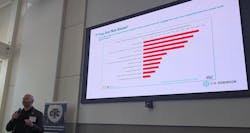Freight Market Volatility Keeps Pressuring Transportation Costs
“Disruptions du jour” are the defining feature of today’s freight transportation environment—and the volatility itself is proving more costly than many of the underlying policies, according to Ryan Hammett, director of market intelligence and insights at C.H. Robinson, a global third-party logistics provider.
Speaking at a recent meeting of the Traffic Club of Chicago, Hammett emphasized that rapidly shifting trade rules continue to unsettle supply chains far more than the tariffs alone. “The tariff volatility is way more disruptive than the tariffs themselves,” he said. “Business is pretty much saying, just give me the rules and I can play with them—but stop changing them, please.”
According to Hammett, the freight market is being reshaped simultaneously by unpredictable global trade actions, uneven federal regulatory enforcement, and persistent pressure on carrier cost structures. DOT crackdowns—on issues from English-language proficiency to documentation requirements—are creating pockets of capacity disruption, though he noted that headline-making enforcement numbers can obscure the smaller real-world impact on overall for-hire capacity.
Carriers, meanwhile, continue to battle an imbalance between rising operating expenses and flat or declining rates. Driver pay, insurance, equipment, and legal exposure remain elevated, eroding margins and contributing to a steady drip of carrier exits. “The last four years have been a big alligator mouth,” Hammett said, with costs rising and revenues struggling to keep pace.
On the ocean side, Hammett noted, carriers face a different challenge: excess capacity. Even as tariff pull-forwards have caused brief rate spikes, global steamship lines remain “massively oversupplied,” keeping downward pressure on long-term contract rates.
Demand-side conditions offer little relief. Consumer spending remains bifurcated, with lower-income households pulling back and higher-income households propping up overall retail activity. That dynamic, Hammett explained, has kept freight demand muted. Route guides remain stable, and C.H. Robinson forecasts only a modest 4% cumulative increase in dry van spot rates next year—an uptick, but far from a significant rebound.
Despite the turbulence, Hammett urged logistics leaders to distinguish between policy discussions and implemented rules, to scenario-plan around uncertainty, and to remember that the market is ultimately a complex system. “There’s not just one thing that’s going to make the market,” he said. “All of these conditions work in concert.”
Ryan Hammett, speaking at a recent meeting of the Traffic Club of Chicago.

